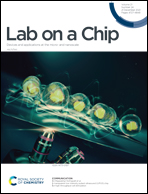Interfacing droplet microfluidics with antibody barcodes for multiplexed single-cell protein secretion profiling†
Abstract
Multiplexed protein secretion analysis of single cells is important to understand the heterogeneity of cellular functions and processes in healthy and disease states. However, current single-cell platforms, such as microwell-, microchamber-, or droplet-based assays, suffer from low single-cell occupancy, waste of reagents, limited sensitivity, or inability to perform necessary operations, etc. To overcome these drawbacks, we present an integrated droplet microfluidic device that interfaces with spatially patterned antibody barcodes for multiplexed single-cell secretome analysis. The trapping array of 100 picoliter-sized isolation chambers could achieve >80% single-cell capture efficiency with >90% viability. The single-cell analysis microchip was validated by the detection of four-plexed cytokines, including IL-8, MCP-1, MIP-1b, and TNF-a/IL-10, from unstimulated and lipopolysaccharide (LPS)-stimulated individual human macrophages. We also successfully applied the platform to profile protein secretions of human tumor cell lines and primary/metastatic cancer cells dissociated from cancer patients to observe the secretion heterogeneity among cells. This unique microfluidic platform enables multiplexed secretion assays for static droplet microfluidics, provides a reliable and straightforward workflow for protein secretion assays based on a low number of single cells in a short incubation time (∼4 h), and could have widespread applications for studying secretion-mediated cellular heterogeneity.



 Please wait while we load your content...
Please wait while we load your content...